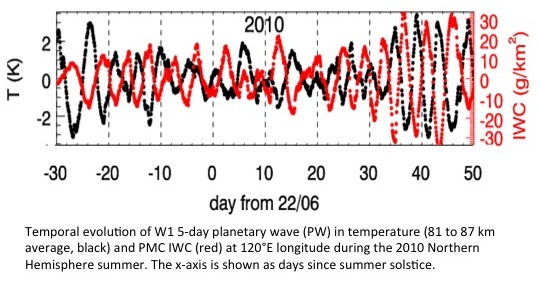|
STATUS:
05.16.2015
Instrument Status:
The AIM spacecraft continues to perform well. All subsystems are operating as expected.
CIPS:
The CIPS instrument continues to perform well, with no health issues. Daily daisies are being posted each day on spaceweather.com again, as in previous seasons. As of this writing, no clouds have yet been detected for the NH15 season. Because of the beta angle changes, the CIPS sampling has changed significantly over the past couple seasons. One issue is that the CIPS science images have been starting before the spacecraft has had time to roll back to nadir-pointing, after the SOFIE occultation. A time delay was added to the image sequence in order to delay the first light images by 3 minutes. This was implemented and tested in April, and will remain the standard operating sequence for the NH15 season. The figure below compares the CIPS sampling on the last orbit before the change took place (orbit 43820) to the first orbit after the change took place (43833). This figure shows camera pixels that are color coded according to the number of measurements in the PMC phase function that CIPS measures. Red pixels indicate 6-7 points in the phase function, so these are the highest quality data. Blue means 4-5 points and black less than 4. Note that many of the "red" pixels in orbit 43820 were on the dark side of the orbit. This has been fixed with the addition of the time delay. The overall effect is to increase the number of high quality data points, and to shift the data to lower solar zenith angles (and lower latitudes) on the descending node of the orbit.

Figure caption. CIPS sampling for orbit 43820 (top) and orbit 43833 (bottom). Pixels are color coded according to Quality Flag (QF), where QF=0 means 6-7 points in the phase function, QF=1 means 4-5 points, and QF=2 means less than 4 points. The higher the number of points in the phase function, the more robust the retrieval, so red points indicate the highest quality data. A 3-minute delay was added before the first science images in orbit 43833 to avoid problems caused by changing sampling as the beta angle has changed.
SOFIE:
The SOFIE instrument continues to operate normally. Liu et al. [2015, JGR, in press] recently used SOFIE observations to diagnose 5-day planetary waves (PWs) with zonal wavenumbers ranging from -1 to -3 (eastward propagating mode, E1 - E3), 0 (stationary mode, W0), and 1 to 3 (westward propagating mode, W1 - W3) in the polar stratosphere and mesosphere. The 5-day PWs in temperature are stronger in the polar winter stratosphere and mesosphere and exhibit substantial hemispheric asymmetry. The occurrence of the 5-day wave coincides with the zonal mean zonal wind in each hemisphere. This indicates that the 5-day PWs might be generated from barotropic / baroclinic instability in the polar stratosphere. The relative strengths of 5-day PWs decrease with increasing wavenumbers. The E1 (W1) 5-day PW is stronger than any other mode in winter (summer) and in the stratosphere and lower mesosphere (upper mesosphere). SOFIE temperature and polar mesospheric cloud (PMC) data are derived from simultaneous measurements in the same air column and thus provide a good opportunity to study the phase relationship between the 5-day PWs in temperature and PMCs. This study used the vertical column ice mass abundance (or ice water content, IWC) to represent PMCs. The analyses shows that W1 5-day PWs in T and IWC are ~180° out of phase when their amplitudes are substantial (see Figure below). Furthermore, the phase shift of W1 5-day PW in temperature relative to that in IWC has a mean of -2.0 h (0.3 h) with a standard deviation of 3.8 h (4.2 h) in the Northern Hemisphere (Southern Hemisphere). These results indicate that the formation of the W1 5-day PW in PMCs is controlled mainly by the W1 5-day PW in temperature.

|
